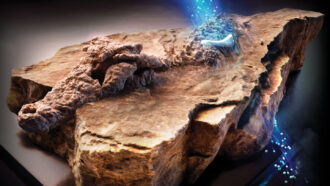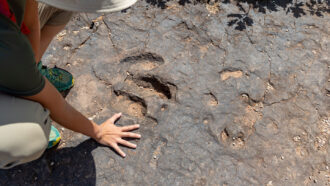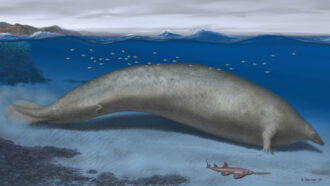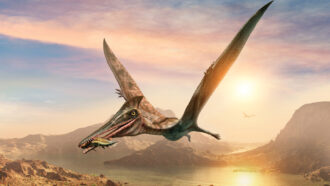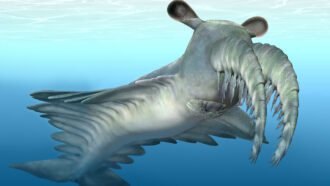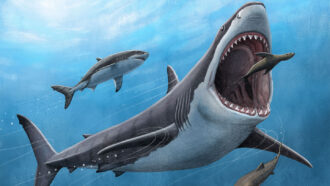‘Frankenstein’ dino showed a mashup of traits
It brings together features of two radically different groups of dinosaurs — the leaf-eating Brontosaurus and meat-eating T. rex.
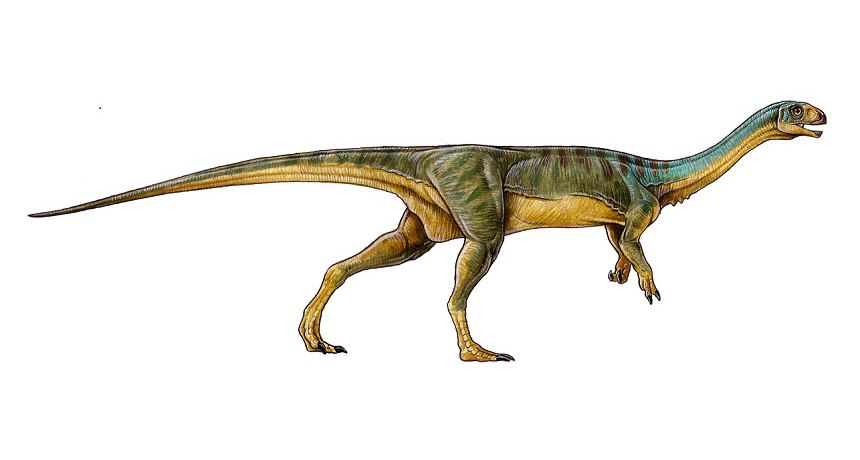
Fossils found in Chile reveal a new dinosaur species with a mishmash of features — a little T. rex mixed with a bit of Brontosaurus.
Gabriel Lío
Frankensaurus did exist. But don’t worry — this sharp-clawed dino was a vegetarian.
Bones found in South America reveal a bizarre new dinosaur. Based on an ancestry that links it to Tyrannosaurus rex, this reptile should have been a meat eater. Instead, it preferred plants. Researchers described the new species April 27 in Nature.
Its genus name — Chilesaurus — reflects that it was found in what’s now Chile. The team that discovered the fossils gave it a species name of diegosuarezi to honor Diego Suarez. While just 7 years old, Diego found the first dinosaur bones in the same general area of Chile. It’s a place known as the Toqui Formation.
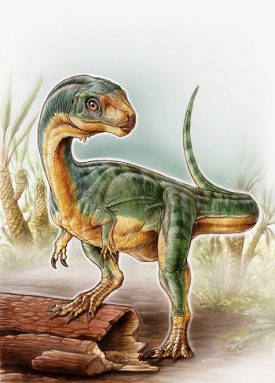
“Chilesaurus is so unexpected, so drastically different than anything else we’ve seen before,” says Lindsay Zanno. “It’s an anatomical Frankenstein,” says this paleontologist. She works at the North Carolina Museum of Natural Sciences in Raleigh.
C. diegosuarezi roamed South America 150 million years ago. It measured about 3 meters (roughly 10 feet) from head to tail. Its sturdy back legs, thin body and short, stout arms made it look a bit like T. rex. But it also had a long neck, small head and a mouth full of leaf-shaped teeth. Those gave it a Brontosaurus-like appearance. And like the Brontosaurus, it would have eaten plants, making it an herbivore.
This dinosaur’s bizarre mash-up of features made it hard to know to which dinosaur group it belonged, says study coauthor Fernando Novas. He’s a paleontologist at the Bernardino Rivadavia Natural Sciences Museum in Buenos Aires. It’s in the capital of Argentina.
Using several computer analyses, Novas and his colleagues compared the features of C. diegosuarezi with those of many other types of dinosaurs. The results revealed that the new animal was an early theropod.
Meat eaters like T. rex have made this class of dinosaurs famous. And, as a result, scientists had thought that all theropods were carnivores. But studies have begun to suggest that some theropods evolved into plant eaters, says Peter Makovicky. He’s a paleontologist at the Field Museum in Chicago, Ill. A lot of the fossils suggest that this switch in diet is based on tooth shape. It appears to have started roughly 125 million years ago.
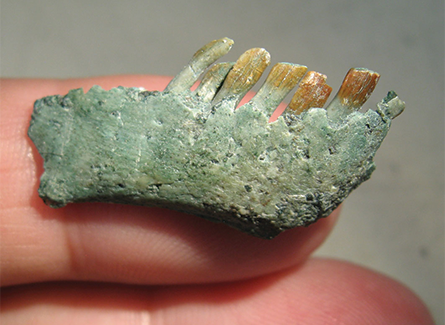
Theropod dinosaurs are perhaps the best example of a meat-eating predator, Zanno notes. So even 10 years ago, she says, no one would have imagined that theropod dinos “would turn out to be one of the best evolutionary case studies for how animals adapt to plant-based diets.” Figuring out how and why certain animals in this family made the switch will be exciting, she says.
Paleontologists used to think that dinosaurs were similar across the continents — at least during the Jurassic period, says Novas. C. diegosuarezi’s mix of features now brings a wrinkle of doubt to that idea. The Jurassic ended roughly 145 million years ago. “South America may have been a cradle for different kinds of dinosaurs that were not found elsewhere in the world,” he now says.
Makovicky agrees that dinosaurs in South America might have been different. But, he adds, scientists will need to find more dinosaur fossils from that continent before they can know for sure.
Power Words
(for more about Power Words, click here)
anatomy (adj. anatomical) The study of the organs and tissues of animals. Scientists who work in this field are known as anatomists.
behavior The way a person or other organism acts towards others, or conducts itself.
carnivore An animal that either exclusively or primarily eats other animals.
dinosaur A term that means terrible lizard. These ancient reptiles lived from about 250 million years ago to roughly 65 million years ago. All descended from egg-laying reptiles known as archosaurs. Their descendants eventually split into two lines. They are distinguished by their hips. The lizard-hipped line became saurichians, such as two-footed theropods like T. rex and the lumbering four-footed Apatosaurus. A second line of so-called bird-hipped, or ornithischian dinosaurs, led to a widely differing group of animals that included the stegosaurs and duckbilled dinosaurs.
evolution A process by which species undergo changes over time, usually through genetic variation and natural selection. These changes usually result in a new type of organism better suited for its environment than the earlier type. The newer type is not necessarily more “advanced,” just better adapted to the conditions in which it developed.
evolutionary An adjective that refers to changes that occur within a species over time as it adapts to its environment. Such evolutionary changes usually reflect genetic variation and natural selection, which leave a new type of organism better suited for its environment than its ancestors. The newer type is not necessarily more “advanced,” just better adapted to the conditions in which it developed.
fossil Any preserved remains or traces of ancient life. There are many different types of fossils: The bones and other body parts of dinosaurs are called “body fossils.” Things like footprints are called “trace fossils.” Even specimens of dinosaur poop are fossils. The process of forming fossils is called fossilization.
herbivore A creature that either exclusively or primarily eats plants.
Jurassic Lasting from about 200 million to 145.5 million years ago, it’s the middle period of the Mesozoic Era. This was a time when dinosaurs were the dominant form of life on land.
paleontologist A scientist who specializes in studying fossils, the remains of ancient organisms.
predator (adjective: predatory) A creature that preys on other animals for most or all of its food.
theropod A usually meat-eating dinosaur that belonged to a group whose members are typically bipedal (walk on two legs). They range from small and delicately built to very large.
tyrannosaur A line of meat-eating dinosaurs that began during the late Jurassic Period, about 150 million years ago. These species persisted into the late Cretaceous Period, about 65 million years ago.
Tyrannosaurus rex A top-predator dinosaur that roamed Earth during the late Cretaceous period. Adults could be 12 meters (40 feet) long.


